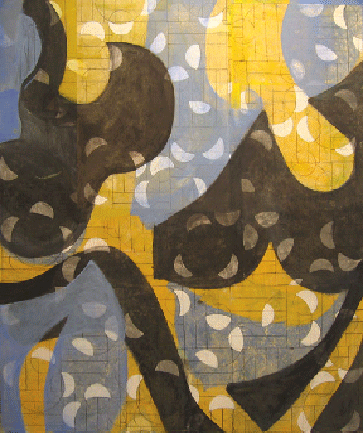Roberto Juarez’ painterly, geometric contradictions
Roberto Juarez fills the Charles Cowles Gallery with colorful abstract paintings that recall Shaker “gift” drawings from the 19th century. Networks of grids, drawn with chalk on rice paper, contain layers of diagrammatic systems of patterned circles reminiscent of the phases of the moon. Setting up contradictions between the painterly and geometric, Juarez manages to suspend our ideas surrounding the graphic image and our more sensual pleasures that only great painting can address.
Using ideas of collage, Juarez freely combines materials like paint, billboard advertisements, paper, chalk, and silkscreen to reach into his ordered chaos, letting us pay attention to more visceral matters.
In the painting “Triangulation 2” (2004), the earliest painting in this show, various shades of blue and green triangular shapes dance across a linear, blue chalked grid, obscuring brushy modern forms hidden on an earlier layer. “Albany” (2006), follows the same formula of stacking grids, but here embraces fleshy reds and yellows and introduces a systemic circular motif that seems desperate to find it’s order. “Ybor City” (2006), recombines motifs but plays with color and scale reminiscent of Lee Krasner collage paintings.
Juarez also refers to different modes of historical periods of art making. You can see the pedagogical influence from Picasso and Matisse, through Pollock, Marden, and Taaffe as well as his own painting history. Juarez emerged as an artist in the late seventies ‘70s and early ‘80s and has allowed himself the freedom to explore many ideas within in his painting oeuvre. He has once again produced a rich and broad summation. Somehow he manages to keep his identity while pushing into new territory avoiding the common traps of formula and manner.
The rear room of the gallery holds the most fascinating art. Here the work seems to recombine into something new and fresh. In this room it looks like he reversed his process and ripped off an epidermal layer exposing the inner workings and secrets hidden within the painting. In his “Los Teenagers” (#6, #4, and #3), the palette changes to rich earth tones of browns and ochres and his shapes are playful and unpredictable while interacting with printed dotted billboard paper grounds. In “Mira” (2006) his round and elongated powder blue and yellow shapes would make Matisse proud, while “Thirty Something” (2006) is one of the most successful and beautiful paintings I have seen in a long time.
In these, his latest paintings, he achieves a humility and beauty that reaches for the sublime.
gaycitynews.com


































